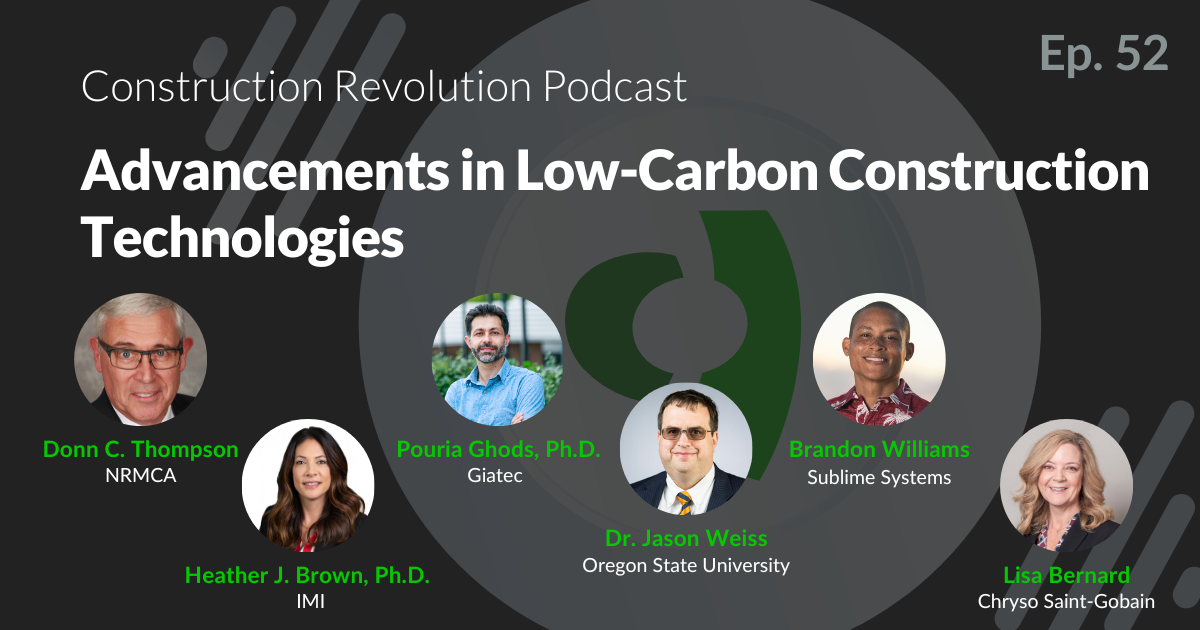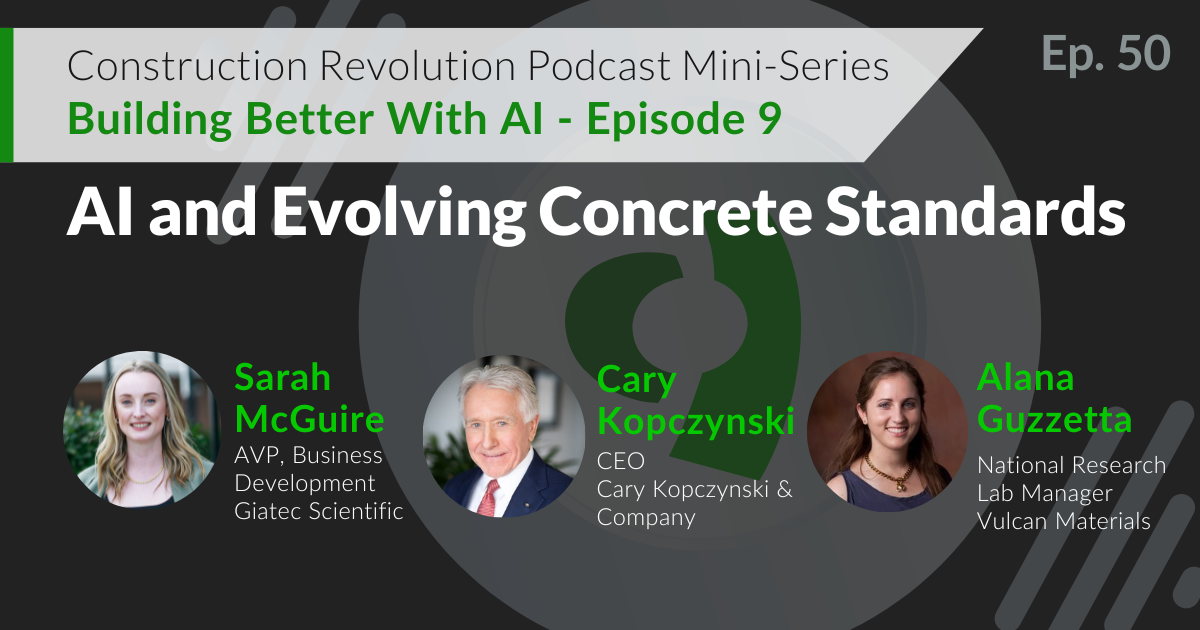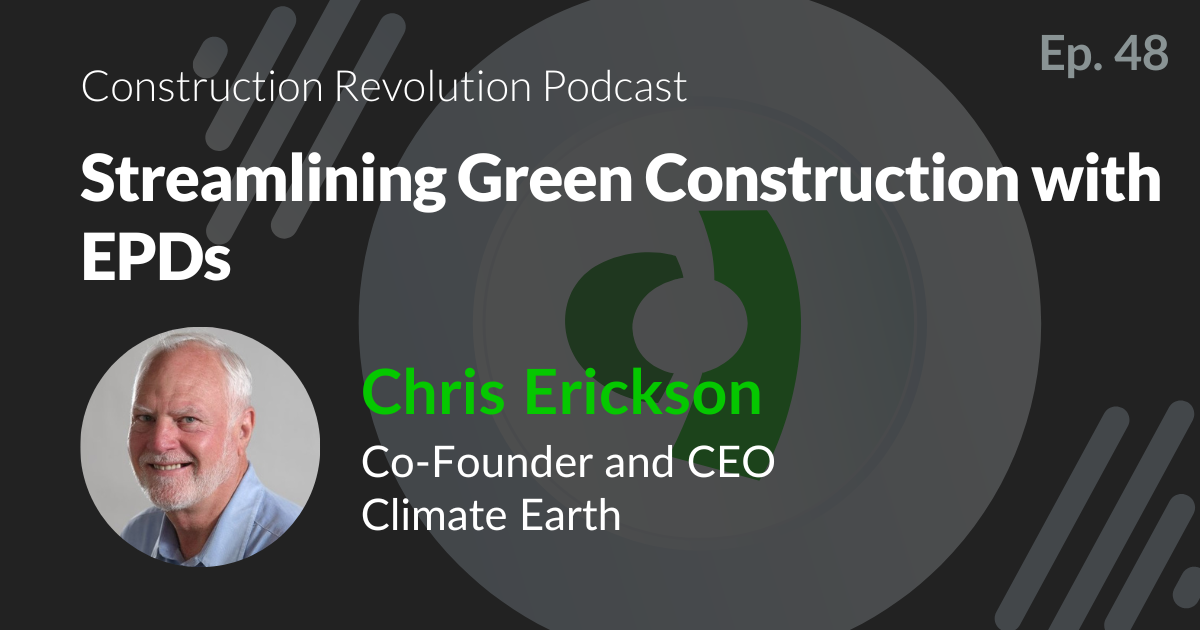
Episode 2 |
April 13, 2021
Setting the Foundation for Our Future
In This Episode
In this episode you’ll hear from world renowned experts and leading tech innovators from around the world on the actionable steps we can take to create a sustainable construction industry. This panel discussion was originally recorded in January 2021, at the Net Zero Construction Conference.

Host
ERIC YEE
Content Marketing Manager, Giatec Scientific Inc.
Guests
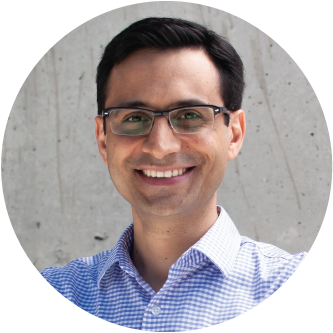
Dr. AALI ALIZADEH
Co-Founder & CTO, Giatec Scientific Inc
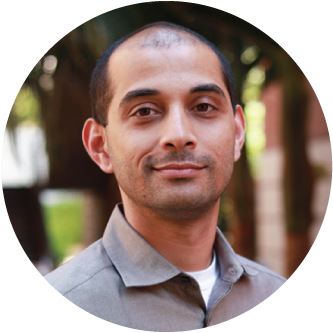
Dr. GAURAV SANT
Civil, Environmental and Materials Science Professor at UCLA and Founder of CO2Concrete
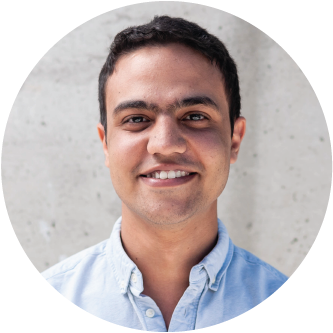
ANDREW FAHIM
Senior Manager of Research and Development, Giatec Scientific Inc.
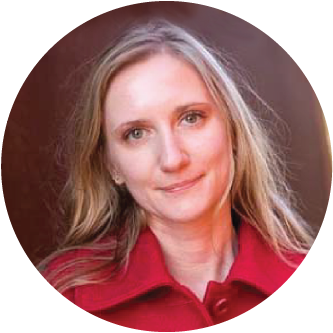
STACY SMEDLEY
Director of Sustainability at Skanska USA, and Executive Director at Building Transparency

Dr. PHIL DE LUNA
Director, Materials for Clean Fuels Challenge Program, National Research Council Canada

CHRISTIE GAMBLE
Senior Director of Sustainability at CarbonCure Technologies
Podcast Transcript
Aali:
Hello, and welcome to our panel discussion on setting the foundation for our future as part of the Net Zero Construction Conference. My name is Aali Alizadeh, CTO and co-founder of Giatec. I’ll be moderating this panel discussion. It’s a great pleasure to host a group of experts from industry, academia and government who will bring different perspectives on the opportunities and challenges in the development and adoption of solutions and technologies to address sustainability issues in the construction industry.
For the audience, if you have any questions throughout the talk, please share them in the chat area. And we’ll answer them at the end of this panel meeting. So without further ado, let’s just start with the introduction of our panel members, and learn about the area of their expertise. Stacy.
Stacy:
Hey everyone. My name is Stacy Smedley. I’m currently the executive director of Building Transparency, which is a newly established nonprofit in 2020. That’s mission is to enable the tools and data necessary for actual embodied carbon reduction and make sure that’s free open access tools and data. My other hat is as director of Sustainability at Skanska, USA. And in that role, I am supporting projects and all of their green commitments as well as a subject matter expert in carbon of construction.
Aali:
Thank you, Phil.
Phil:
Hi everyone. My name is Phil De Luna, I’m a director at the National Research Council of Canada, which is the government of Canada’s national lab system. I lead a seven year $57 million collaborative research program called The Materials for Clean Fuels Challenge program. My program has three main thrusts, CO2 conversion, clean hydrogen production, and AI from materials discovery. I’m really happy to be here.
Aali:
Thank you, Phil. Gaurav.
Garauv:
Hi everyone. Gaurav Sant, I’m a professor of engineering at UCLA, but I’m also the director Institute of Carbon Management. And obviously given the complexity and the quantity of material flows and energy flows associated with construction. We’re interested in the de-carbonization of the construction sector.
Aali:
Thank you. Christie.
Christie:
Hi everyone. My name is Christie Gamble. I’m the senior director of sustainability with CarbonCure Technologies. CarbonCure is working with the cement and concrete industry to decarbonize concrete. We’re on a mission to reduce 500 mega tons of carbon emissions annually by the year 2030. I’m also a board member of the carbon leadership forum, a group that’s working to reduce some carbon in the built environment. And if you happen to notice earlier, the nature of working from home, I’m joined by my assistants, Leo the cat.
Aali:
Thank you. Andrew.
Andrew:
Hi everyone. My name is Andrew and I lead research and development within Giatec. As you may know, Giatec is on a mission to use sensors as well as AI and machine learning to advance analytics that relate to concrete and how we can use this to use carbon emissions within the concrete sector. I specialize specifically in sensor development or prototyping of sensors, as well as in data science and machine learning.
Aali:
Well, thank you everyone, and welcome to our panel. So, let’s start with our first topic in question. Over the past decade, there has been significant activity in the development of technologies and new materials with the goal of reducing the carbon footprint in the construction industry. What are the technologies that you see having great potential in the green construction space and why. Perhaps we can start with Stacey?
Stacy:
Sure. Well, first of all, I think, yes, it’s true, that has been happening for a decade or more, but I think in the past, I’d say less than a handful of years, maybe two to three, we’ve seen just a dramatic uptick in this when it comes to both material innovation and carbon reduction at the manufacturing stage. But also with the use of data and software to actually inform our choices and really spur low carbon procurement.
So, I’m so excited about what I’m seeing in both the concrete, cement and steel space. I think there’s still some work to be done with timber and how we can get to the source of things in the forest. I think that’s one that is just a really big challenge, but when it comes to some of the innovations around things like CarbonCure where we’re looking at how we can actually sequester carbon, reduced cement content, and then with hydrogen for steel, I think there’s just a lot of really good things happening.
And a lot of now funding that we’re seeing going towards these things over the past two to three years through Breakthrough Energy ventures, which is CarbonCure, but also Amazon and [Bezos 00:04:34]. And just, all these tech companies that are now doubling down on the supply chain.
Aali:
Great. Thank you. Phil, what are the solutions that you are most excited about?
Phil:
Yeah. Absolutely. I think first and foremost, we have to recognize that there are a real range of solutions, which make the most sense in different jurisdictions. And when I say the ones that I’m most excited about, it doesn’t necessarily mean I’m precluding biomass in this situation or other sorts of technologies. I think often in this field, when we talk about clean technologies, de-carbonization in the construction space or any other hard to abate industry, you’ll often inevitably run to why this and not this, why are you saying that and not mine, for example.
And I think it all boils down to the geographic location, what the access to materials are, what the energy grid and supply is, a solution that works in Quebec will not be the same solution that works in Alberta, not the same solution that works in BC. Whereas Quebec has lots of hydroelectricity and therefore electric chemical, hydrogen production for example, is a really exciting avenue. Whereas in Alberta, you could imagine carbon capture combined with steam methane reforming.
But when it comes to construction, what I’m really excited about and Stacy already stole my thunder with the carbon utilization and concrete and all of these things. CarbonCure is on the line as well, and hydrogen being used in steel production. But I’m actually really interested in technologies that can actually utilize excess electricity capacity and the electric chemical generation of new building materials, whether that’s electric chemical steel, electric chemical aluminum, et cetera.
I really do think that as the world continues to decarbonize, we’re going to see more and more increase in renewable electricity, and we need to find a place to put that renewable electricity, especially in off-peak times. So, that’s what I’m excited about. And I think it makes a lot of sense, again, in certain jurisdictions versus others.
And then of course in artificial intelligence, the things that people have been able to do with AI is really exciting. In my own work at the National Research Council, we’re building a brand new facility in Mississauga, focused on making what we’re calling materials acceleration platforms. Essentially, AI driven self-driving labs, these little robots that will make a material, test the material, analyze that material, feed that into a system that uses AI to determine the next material.
So I’m really excited about the potential for that technology. And it can be used in a broad range of different application areas, but of course, construction is one of the largest sectors with which we need to address GHG emissions. So I’m excited about the potential there.
Aali:
Thank you. Very exciting. Gaurav, where do you see the direction of research specifically moving with new technologies from your perspective?
Garauv:
Yeah, so it’s a great question, Aali. I think there’s maybe two or three things that come to mind, right. So we’ve had a large Ballard of technologies that have come about at the academic discovery phase. I think wherever you see in a significant gap is the fact that the gap between discovery and translation still remains to be closed. And I think that’s particularly important.
I emphasize this particularly in the context of something like construction, which is extremely cost-conscious industry. So we really need to still figure out how to drive down cost. And I think this is something that’s really not true. And so I think the big opportunity at one end would be such as, really how do you drive costs down?
A good example I would be thinking about it as what they focused on thinking about carbon capture, as an example. Capture is still effectively unfordable for almost every single industry that you can think of. And frankly speaking, if you want these things to become a significant part of the solution palette, so to speak, the cost has to go down.
At the same time, I think we need to take a step back and think about is carbon capture really the only solution there is. And I think there’s a great case to be made. The answer is probably not. We need to be thinking about solutions that can scale without a need for capture. I think that’s the first part. The second thing would be keeping in mind is, I think we’re very focused on thinking about dropping replacements for existing materials, and there doesn’t seem to be that much of a focus on new materials.
And I think this is perhaps a time of opportunity, where we should be thinking about really, “Is there a world beyond the traditional cement, the traditional steel and the traditional aluminum that we know?” I would postulate that the answer’s yes. And I think, again, this is a role where both academia, but also companies need to be playing a role because we developed such a enormous amount of, I would say, confidence, but also use inertia with switching to anything different then we need to ride that ship.
The last comment that I would make is really related to AI. While there’s lots of talk of AI, the frank reality is, the application of AI in base manufacturing and construction is very, very, very immature at this point. The idea of really organized data pools, build them together, learn of ways to share them, learn of ways to really exploit them. There’s an enormous amount of work to be done.
And I think this is particularly important in sectors like construction, which fundamentally speaking are terribly inefficient. And we make up for our… And the reason that we have inefficiencies is [inaudible 00:09:40] but really very often it’s a question of over-design, which isn’t perhaps managed because you can reduce the amount of quality control that you need to put under the process.
But there’s potentially just huge efficiencies to be gained. And GHG reductions to be heard, by improving efficiencies. And so, I think there’s a huge amount of work that AI could be doing with really building out data pools that show you the cascade pathway along which you really extract these efficiencies. And I think those are two great places to go.
Aali:
Thanks so much, Gaurav. So Christie, we talked about carbon capture and as a technology-based company, how do you see the future of green technologies, particularly recycling carbon in concrete?
Christie:
Well, the concrete as the most abundant man-made material in the world has so much opportunity and potential. There is a large carbon footprint that comes from concrete through the production of cement, but concrete also has this ability to sequester and to chemically convert carbon, which makes it an opportunity to become a carbon sink.
So the concrete industry has a path towards de-carbonization where there not only opportunities to reduce carbon within concrete, but to utilize carbon through various methods throughout the supply chain and to essentially use concrete that’s being used in construction across the globe as a method to get rid of carbon that’s captured from all different types of industry and sources.
Aali:
Great. Thanks. Andrew, what are the new developments that you are excited about, and you can see it playing a role in the future of green tech?
Andrew:
Yeah. Thanks, Aali. There are a few things that I’m super excited about them. One of the things is some of the work that Stacy’s doing with Building Transparency, I’m following all of this work. And it actually goes to Gaurav’s point of, “We need to collect a lot more data.” We need to make this data available to everyone before we can talk about AI and machine learning and data science and all of these things and what they can do.
And some of the work that Building Transparency is doing for instance, on collecting EPDs or a whole lifecycle assessment, these are where we need to start before we start saying AI will take over a lot of what we do. But I’m also very excited about AI and machine learning and what they can do, as I think we still have a lot of inefficiencies in how we use our materials or how throughout the whole process, or the whole chain that we have in construction.
We are producing a lot of information. We’re producing a lot of data, and I think it’s a very good time for us to start using those algorithms and developments that they have made in a lot of different fields to drive efficiencies for instance, and how we optimize our mixtures or how we optimize the billing materials that we have.
And it really goes back into everyone collaborating in this. And I think so many different stakeholders need to work together in order for us to be able to have access to this data, have it so that the researchers can work on it, as well as industry collaborating on it. But the other things I’m also excited about a lot of advancements in the materials side of it.
So whether it’s just alternative binders or everything that we’re doing on the concrete side, or even newer materials that are being introduced, and how we can optimize the use of these, putting in consideration the limitations that we have in terms of how available these materials are, for instance. I’m very excited about those two areas.
Aali:
Thank you, Andrew. So moving to the second question, as you all just discussed, there’s a lot of cool tech out there with clear value and contribution to the nets of your construction concept. In your opinion now, what are the challenges in the adoption of these technologies in the industry? At the end of the day, we would like to get the ideas from concept, all the way to the adoption in the industry.
So it would be great to hear your perspective on the challenges that we have in production of these technology. So let’s just start with Phil. What is the role of government particularly, say on the regulations, building codes of standards or even incentives that can be provided to help with the adoption of Pretech?
Phil:
Yeah, that’s a great question. So the National Research Council of Canada is actually responsible for the technical development of the building standards codes in Canada. And while that’s not the research center, that I’m a part of, the construction research center does such really amazing work in that space.
When we’re thinking about the role that government has to play on technology development in general, it’s really to be that bridge and help you risk technologies outside of the low TRL, to bring technologies out of the lab where the universities and the academics have done such a wonderful job in pushing the barriers and publishing great papers.
But they’re not necessarily incentivized to do the rough and dirty work of trying to scale that out. Do the testing, do you risk it, to get to perhaps a stage where either a company could take it on, a license could be made or a large industrial can move forward. So I think the government has a lot of… There’s the rules that government has to play in setting the policy, in the direct development of psychology, through research and development in national labs and other places, and through providing funding to projects.
I’ll give you an example, the Canadian Infrastructure Bank, which is the [inaudible 00:14:57] investment vehicle that has been established to fund very, very large capital intensive infrastructure projects. And a lot of the focus on that is also on projects that have low GHG emission impacts or have pathways towards de-carbonization. So I really do feel government has a strong role to play in being a connector between sort of the low and high technology readiness levels.
The problem actually that I find with government and again, these visits are entirely of my own is the work that’s done on the public service side of things and the direction that is set by politics that may change depending on who’s in power. And there’s always a tight line to walk between those two, to ensure that the work that the government does as a whole can support technology innovation while also being able to address the mandates and needs of the government of the day.
Aali:
Great. Thank you, Phil. So Gaurav, someone has referred to this as, from benches to the trenches. What can be done to accelerate or help with this process?
Garauv:
Yeah. I think it’s a good question. So I think a couple of comments. Beyond all the things that Phil just said about data skin, et cetera. One of the issues that I think we have in construction is we’re very used to the idea of one size fits all. One size does not fit all. And I think this is something that we fundamentally half of them might.
The second garment is if you look at adoption pathways of how long does it take from a discovery tool to an invention of the material, any of the above typically making in our commercial practice, if you’re on a large Fortune 500 company, that period of time was about 14 years. This is just for a single company to bring a new product to market.
If you go out to the next step and you say, okay, now you’ve got a product that comes to market. How long does it take, for example, for a typical product in the construction industry to become broadly used? You’re talking about years, if not decades. And the issue is, the timeline of this transition is simply not single the rate over which we want to try and make a difference.
So I think, one of the big things that really needs to happen is we need to be developing these really accelerated fast deployment pathways, not simply where technology reaches the stage of manufacturing, but you’ve got to user community and a user base that’s willing to take on some risks and do something new. Because the reality is without a market pull or push, as you will, it simply does not come into practice.
And I think this is where government’s been starting to be a big role because procurement can start to drive some of these things into really accelerated practice. I think the other thing we need to really be thinking about here, however, I think it’s important to think about skill. And there’s a huge skill mismatch very often in terms of what we’re talking about.
For example, if you take a cement plant that produces a million tons of cement a year, it’s producing somewhere around seven to 800,000 tons of CO2. There is almost no way that all of the CO2 produced by that plant is going to get used at a single site. So we really need to be also changing the basic practice around how we think markets are structured, and markets work. We need to be thinking about diffuse.
We need to think about distributed manufacturing. We need to think about modular systems. And we really need to change the business practice, which goes from economies of skill, which is how we function to distributed modular systems that can operate in a diffused manner across the geography. This is not important fit for a large country like Canada or the U.S., this is important wherever on the world you are.
And I think all of this needs to become systemically a part of how we approach the total balance of thinking about carbon management, which is something we haven’t been doing.
Aali:
Thank you, Gaurav. Christie, you’ve had a very successful experience getting your technology adopted in the construction industry. Can you share some insights about challenges that you had to overcome, and what is your take on getting technologies like that. In general, Pretech adopted in the construction industry?
Christie:
Absolutely. Well, the concrete industry has a bit of a reputation for being slow to adopt new innovation. And in fairness to the industry, the industry is responding to the market and what they’re able to supply. So CarbonCure to date has been utilized in over 6 million cubic meters of concrete. We’ve saved over 100,000 tons of CO2 through CO2 utilization.
A huge amount of that production has happened within the United States. Part of the reason for that is because the environment of construction in the States is more open to innovation than the environment for construction in Canada. And in fact, policy in government procurement can make a big difference in that impact.
Government accounts for almost 30% of construction of concrete procurement through infrastructure and government projects and not having a policy that encourages innovation and sustainability in concrete is the same as having a policy that encourage status quo. And that’s really the environment that we tend to see within Canada in particular.
And it’s a big hurdle for us to overcome is the ability to get our concrete products allowed onto construction projects that are being built within Canada and across the world.
Aali:
Thank you, Christie. Andrew, what do you hear your touch with a lot of producers, through the use of AI especially the area that you were working on. What do you hear about the adoption of AI based technologies in particular in the industry?
Andrew:
Yeah. That’s a great question Aali. We are kind of known for things like always done it this way, or if it’s not broken, why fix it, et cetera, within our industry. So traditionally, and this is understandable considering the very capital intensive and very high-risk projects that we deal with. It’s certainly something that is understandable.
But I totally believe that this transition is probably the hardest part of product development. I mean, we need to develop products that do not just work or are not just reliable or even competes with the business as usual, but also provide significant value, prove to be obviously profitable for them. So to be honest, even the greenest products do not just work because they are green.
Like we need to drive a significant value with these end users. So one of the things that help us at least at Giatec when we develop products is listening to end users. So, what are the requirements? What would help them? And I think in a lot of the developments that are being done, there is some research that’s done for fundamental research and that’s totally understandable.
But in the end, those end users are going to be the ones using it. They’re going to be the ones driving value with it, et cetera. So, we certainly need to help them. But I think another thing that helps a lot is collaborative research. So work that we do with pure fundamental research with universities and working with other industry people, it does help significantly in this transition.
And I think the governments play a significant role. As Christie mentioned, in the end they are the biggest purchaser, they are the biggest spender in terms of that. So helping with, whether it’s just policy or other things that relate to standards, because we are dealing with consensus based standards. So it does take quite a bit to develop and to adopt, et cetera.
I think we need to spend quite a significant amount of time expediting this, because we are talking about goals that we need to meet by 2030 and 2050. So the clock is ticking. We’re really talking about just a few years from now. And when we’re talking about the standard, that takes 10 years in a consensus based method to develop it significantly over the deadlines that we have, and the ambitions that we have for this.
So I think that’s really what I think about the standards or the goals or the role of government in this.
Aali:
Thank you, Andrew. Stacy, as an industry leader, how do you look at this from the cost versus impact perspective and Gaurav touched on this a little bit that at the end of day, we have to drive the cost down, increase the value. You are in business, and the bottom line is the most important thing for any for-profit business. How do you look at it from that perspective and what are the challenges that you see needs to be addressed in adopting green tech in the construction sector?
Stacy:
Contractors in general are reflecting what their owners are asking for a lot of the time. So we are meeting their budget. We are meeting a schedule that we set that we’ve committed to for them, for a project they want built by a certain day. So the way that Skanska’s approached it, that really led to the C3 tool being developed was we’ve got to put carbon if companies are now looking at carbon into the same vernacular and approaches costs.
So can we provide the carbon emissions of products next to the costs, and allow the client to decide whether it is the lowest cost option that’s most important, or if it’s the lowest cost and the lowest carbon option that’s important, or if it’s the higher cost lower carbon option. So, I think part of it is again back to the data side, and we’re seeing a move really in the private sector ahead of policy where carbon is becoming just as important as cost.
And there is a balance that way, they might be willing to pay a little more for something, if it’s going to reduce the carbon emissions and meet their carbon goals. So that gets into the demand and the signal to market that I think has led to why CarbonCure, for Christie’s example, has been more adopted in the States, because there are these now private clients that are saying, “Well, carbon’s something we’re tracking in a metric that is becoming even as important as cost, because it’s something we’re reporting to our stakeholders, and to the people that buy our products that we build in these buildings or that we make in these buildings.”
So I’m actually pretty positive about where we are with this in the States right now, when it comes to at least being able to bring it to the surface and allow some decisions to be made on both cost and carbon in the construction space. And that’s really what we’re here to do as a contractor is provide that data to somebody who could make the choice on procurement.
Aali:
Thank you, Stacy. Yeah. So, let’s move to the next topic and question. They say the road to success, and in our case, building a green environment is always under construction. I was hoping you can share some insights on what you have learned about the changes in the industry, and you’ll have mentioned about the fact that construction is so slow to adopt technology.
But how has green construction in particular has changed over the past 10 years or more? And what are the takeaways and learning a sense from your perspective? Let’s start with Gaurav.
Garauv:
Thanks. Thanks Aali. Happy to respond. I think that’s a couple of things. So as I look back over the past 10 years or even the last 15 years, there’s a couple of things that have, they could end up being changed. I think one of the things to point out is about 15 years ago, there was lots of talk with the fact that we were going to regulate CO2 at one point or another, and it was going to happen sooner than later.
With the financial recession that set in, in 2008, of course, a lot of these efforts fell by the wayside. However, I think one of the things that did happen as well is that, we were very high on promise and competitively speaking, not thinking only about construction. But what I would say is clean tech, so to speak, we were high on promise and competitively low on delivering.
And I think there was a lot of sequential failures that came about, and while failure is never good, if you can learn something from failure that always helps. So I think what has actually arisen from that is we’ve got better processes, better means for diligence, better means for analysis, that really help us look at technologies much more robustly now.
I think thinking also on a different angle, if I think 10 or 15 years ago, and maybe even as long as five years ago, one of the big focuses in construction has really been driven on automation schedule, and really, I would say the construction process. And I think this is one part which I think has started to change. Where now the industry is starting to look at the fact that it’s hostage to its material supply flows.
And the reality is it’s really all of your embodied CO2, which is really the big elephant in the room so to speak. And being able to address an embodied CO2 is particularly important because as you look 10 or 15 or 20 or 30 years old, and as you see electrical grids decarbonizing, all of the carbon footprint of your building, of your materials is all in the materials themselves.
And so I think this is something which has very much come to the forefront, because the reality that now we start to see, and I think this is really where the then versus now is starting to be much more focused. We’ve initially been focused on things that lead to, I would say practical financial improvement, so to speak. Now we’re looking at things where the financial improvements might not be that great, or even could be a disincentive, but the societal impact is large.
I think we’re starting to look at problems which have much bigger significance. They have longer time horizons to success, no question, but these are really the hard and the would be problems that I think we should solve.
Aali:
Oh, very good point. Thanks. Christie, how do you see the change over the past 10 years or so, especially I guess with your experience with COVID curated, it would be great to share that with us.
Christie:
Absolutely. Well, I’ll give a very personal experience. So I joined CarbonCure about eight years ago. And when I first started with the company, I was going into design and construction firms, sharing education on what is embodied carbon and why does it matter? And the real change that I’ve seen in the past eight years and particularly in the past two or three years has been widespread knowledge of not only what is embodied carbon.
So the concept of the carbon footprint of the building materials and construction of the building itself, but also how much of an impact it has, and how important and urgent it is to address this problem now. So much of this research has come out of a group called Architecture, 2030. We’ve seen other organizations form and grow like the Carbon Leadership Forum, which I’m so proud to be part of.
We’ve seen transparency come about in the industry. So thanks to tools like EC3, we now have more understanding of the wide range of carbon impacts that come from different building products. And what’s also really key is this urgency to drive emission reductions now. We do know that based off of modeling, if we’re going to reach the goals of the Paris Agreements and start to decarbonize the built environment, we have to start implementing these kinds of solutions today.
We can’t afford to test out different methods and research for the next decade and then start to implement solutions later. So this urgency has resulted in what I have seen is to be a very rapid approach to the way in which people are looking at embodied carbon. And it’s been really encouraging to see, because I think if we can have this kind of a shift within a couple of years, we’ll be able to get the industry to where it needs to be within the next couple of decades.
Aali:
That’s very encouraging. Thank you. Andrew, how do you see the changes happening in the tech space for green construction?
Andrew:
Yeah, I’m also quite optimistic, especially about data availability and people understanding the value that they can drive with this data. So things like the environmental product declarations, that’s something that has boomed, I think within the past couple of years and that’s an excellent trend. We want initiatives like this to increase and we want to encourage these things.
Some other things that I’ve seen is, for instance, use of alternative materials, concrete for instance, or other building materials. And this was something that as far as I see there was a lot of resistance against years back. But now because of a lot of the standards, taking this into concentration and understanding that, “Okay, this is not just because it produces a better material, but also it has an environmental impact.” We’re starting to look a lot more on the positive trends in adopting these things.
So I think we are moving in the right direction, but again, there has to be a sense of urgency in these things. We have very strong mandates in terms of how we approach the environment or how we approach our buildings, that I think we need to move really quickly in terms of that. But I also see a lot of collaboration that is between people like specification bodies or policy makers or DOTs for instance and that we need to move in the right direction.
We all have mandate, we all have a small part to play. And I think by all of us knowing this, I think we’re going to move quite well. So I’m very optimistic by these trends growing, and I think we’re doing a good job.
Aali:
Well, thank you, Andrew. Stacy, from the contractor’s perspective, how were you looking at green tech 10 years ago, compared to how you’re looking at it today? Can you share that experience or perspective with us?
Stacy:
Sure. Yeah. And I want to build a little bit about what Christie and Andrew said too. But to that question specifically, I think that we’re seeing that we have more of a role to play in the construction industry, to either support innovative technologies that are going to make us more efficient and make our environmental goals more achievable or help create them if we need to, like we have with the EC3 and how scans that concede with that tool.
So I think that we’re seeing the role that technology plays in helping us to move the industry to where it needs to be. We are a slow moving industry when it comes to the construction industry, but I think we see tech as a way to actually help speed us up a little bit. And then I think on the other side, I just want to echo the momentum and the uptick of understanding around the whole carbon picture of buildings, this embodied carbon component coming to the forefront.
I think one example that I love to use because it’s exciting for EC3 is that in one year we’ve gone from launching to over 10,000 users of that tool. So there’s over 10,000 people that have gone into that tool and looked at EPDs and started to try to understand the carbon impacts of their products. And the other thing that I’ve learned through the process of EC3 and building transparency is just, I think that we’ve moved from a place of competition around these impacts to collaboration, as Andrew mentioned.
Where companies that would typically compete and want to be first and say, they won now move to a place where saying that they’re going to combine forces and solve the problem together and align on their asks. Which I think is something we’ve learned from materials toxicity and other things where we had 20 different ways of asking for something from a manufacturer who says, “I don’t know what you’re talking about.”
There’s going to be a line on one ask when it comes to the carbon side of things. So those are all positive changes. And I think we’ve learned lessons from past environmental opportunities or problems. And I agree that we’re moving in the right direction and the more that we can align policy, private company commitments, where we source the data from, how transparent is it? All those things the faster we’re going to move.
Aali:
Very interesting. Thank you. Phil, from your perspective, how do you see the changes comparing then and now?
Phil:
Yeah, I think that Stacy made a really good point earlier about how people and companies are demanding, especially from the stakeholder side, lower emissions. You always hear about ESG metrics, environmental, social, and governance being a really big topic right now in lots of governance circles, boards of directors, et cetera. I think that the finance sector has actually done a lot in recent years to promote especially through private investment, large capital investment, institutional investors.
The de-carbonization of many sectors and industries putting a signal to the world that people care about de-carbonization from a risk perspective as well. What we have to think about on climate change is that we have these build environments, but we have to think about the resiliency of these build environments with extreme weather conditions in the future.
And if we aren’t addressing that now, and if financial institutions and governments and policymakers and construction builders and insurance companies are thinking about what that may look like in the future, then they will be sorely and gravely impacted by that inevitably. So I think the world is waking up to that. I also think that the pandemic has actually accelerated a shift away from oil.
A lot of people are saying we may have even reached peak oil. I think a Shell report was announced last year. So I think we’re really starting to see the movement in the right direction. And I really hope that we see an acceleration in the next few years.
Aali:
Thank you, Phil. So moving to our next topic. Obviously, we’ve all discussed the activities that are happening in academia, and the industry, and government and all the challenges that we’ve had. And the goal here is to help with the induction of green technologies and out of the sustainability issues in the construction sector, with the goal of making the world a better place for the future generations.
With that in mind, what can we do to inspire our next generations of students, engineers, and policymakers to continue on this paths? Let’s start maybe with Christie. How is that from your perspective?
Christie:
You starting with me to represent the millennials of the [crosstalk 00:37:01]. I can really speak on behalf of my generation, I’m among the oldest among the millennials, but there’s certainly a lot of education among younger people today on the impacts of climate change and the needs to decarbonize. And I think this is really inspiring a movement.
The next step is to capture that energy and that ambition and turn it into pragmatic solutions that businesses can use to resolve and solve this global challenge. So I think it’s really encouraging that there are viable businesses that can both work towards profitability and also making a better planet. And I think this is very inspiring for young people who want to find careers that can fulfill them.
Who wants to question the status quo. Who might look at the way that a building project is specified and designed and say, “Why are we still doing it that way?” And we need more people to be asking those questions and implementing that change so that the practices keep up with the innovation that’s being developed.
Aali:
Thank you, Christie. Andrew, what is your take on this? Like how can we inspire the next generation of people who are going to be in the green space?
Andrew:
Yeah. Absolutely. Personally, I’ve been very lucky throughout my rather short career to have some amazing mentors, professors, supervisor that sort of have environmental concentration as one of their core values. They truly live with it. So I personally think mentorship for the newer generations will play a significant role in our environmental consciousness and in their environmental consciousness.
So I think we set a very good example and we should always set a very good example for them and how we stand by this. We don’t just say it as a couple of words that we say in a blog or an article, it’s something that we stand with. It’s in every decision that we make and we need to set an example in terms of that. I also think our engineering or science curriculums can do a better job on how they’re having this.
It’s really as strong as pure science is, or as important as pure science is. Especially in this day and time when we really need to make immediate actions or we need to take immediate actions in order to make an impact on our planet. I mean, I personally work with a lot of the younger engineers and younger scientists. We have a lot of them in our team here, so they certainly have a contagious enthusiasm that I enjoy working with.
So they have this belief that they will change the world. So those impresses me, those pushes me to do better and to be the best that I can. So I guess my advice for the younger people is that every single person is going to play a big role in how this works out and we all need to work together to make it happen.
Aali:
Thank you, Andrew. Stacy, what is your take on this? My hope is that one day we refer to green practices as just common practices. We don’t call them green practices anymore. It will be just a common practice, but what is your take on how we can inspire the next generation of engineers or industry leaders to be inspired about the green technologies?
Stacy:
Well, fortuitously right before this call, which is why I was a couple minutes late getting on before we started, was that I was presenting to my son’s fourth grade class, like the entire fourth grade at his elementary school, on water and energy and materials, and then made them draw what they thought a building could look like if it acted like a flower or a tree.
And so I’ve been doing that kind of work for a long time, and I’m very passionate about it. It could be a whole other presentation, but I think, the younger generation, especially when they’re pre, everything has to have a definitive answer. If you show them what’s possible, that becomes what’s possible to them. So we need to start young and educate these kids growing up that this is just how it should be. It makes perfect sense.
And then they’re going to grow up and that’s what they’re going to have as their baseline moving forward. And then on the other side, my LinkedIn post today, I’m doing positive posts this year, was actually googling or, not googling, searching the LinkedIn jobs portfolio for jobs with sustainability in the title. And there were over like 20,000 jobs.
If I had done that when I started 20 years ago, I probably would have gotten maybe five. So I think just empowering those that are interested in the sustainability space, whether it’s building or not, that there is a profession for this. Figure out what major support it, advocate for actual classes or courses that are going to help you get educated on it, because we are in a different place and it’s a very good one when it comes to actually being able to mold your career into something that fully supports that passion.
Aali:
Thanks very much, Stacy. What is your take Phil on this? Can you share your view on how we can inspire the next generation of people joining the industry?
Phil:
Sure. I mean, I still consider myself young and part of that next generation. But I would say that with youth, I actually think that they don’t need any more inspiring, they were taking to the streets in 2019 protesting, and I would say that the rest of the world is inspired by the youth right now, when it comes to the climate file. And Andrew very nicely explained and said, how the young people in his team are pushing him to be better. And I think that’s a beautiful, beautiful thing.
I also think that they recognize that the world that they will live in, the world that we will all live in is coming very quickly. And the impacts of climate change, the impacts of the emissions that have been made up to this point, and that are continued to be made today, will be felt by this generation and generations to come. So my advice to those who are… And actually I think there’s no advice to give to those who are passionate, because the passion is there and people understand.
And I’m actually extremely hopeful because of the amount of, I guess, in political engagement and awareness around this issue and around being green. I agree completely with Stacy that there’re so many more opportunities today than there ever were before. And actually the thing that people should continue to do is to speak to the older people in their lives and advocate for climate change.
Because every CEO that I’ve talked to has had their mind changed about taking climate action and sustainability seriously, by having a conversation with their grandkids at the dining room table and not with some consultant in a boardroom. So continue that work and do things that you love and you’re passionate about, and be adaptable because the world is always, always changing.
Aali:
Well said. Gaurav, as a university professor, teacher, educator, you are in the business of training the next generation of workforce joining the industry of academia. How do you look at it from your perspective?
Garauv:
Yeah. So, of course university is a great place to be because you’re always surrounded by smart people that want to do great things. I think a couple of comments that really come to mind. I think very often we’ve looked at sustainability as implying some sort of a compromise either in performance or in price. I think fundamentally one of the big things that really has to change and is changing systematically is that we’ve got to really clarify that, that’s not the case.
There’s, also unfortunately a bit of a premise which is scrapped out, that if you do something green, it’s going to impoverish the world. I think we have to demonstrate the idea that prosperity and sustainability or making the right amount of choices are not equivalent to each other. And I think that’s the next thing that really point to.
The last thing that really point to is, I think people have a tendency to get into careers and make an impact when they see the ability to make an impact. So right now, at least so far, we’ve seen a lot of work and lots of people enter the workforce because they’re passionate about it. But if you really try and evaluate your impact, how I’ve been able to make a difference, it’s still very diffused.
And I think this is something that we really need to build a better success stories around, because success stories of impact is really what empowers people and makes them directed towards making a career choice in this or in any other field. And I particularly point to the advent of the Facebooks and the Instagrams of the world. Where having a platform that you can access and you know what can do for you, is really an important thing.
Because the issue with things like climate change, the reality is this is unfortunately an experience which is different. You only realize the depth and the intensity of the problem, 10, 15, 20, or maybe 80 years down the road. We live in a beautiful, instant gratification type of world, and so we really need to be able to demonstrate why the efforts that we make and the work that we do today has an important role. Not that you avoid an issue 80 years down the road, but actually make a difference today.
And I think it’s this combination of success stories that are really important to be able to empower people and get them to make choices, to make careers in this field.
Aali:
Yeah. Well, thanks so much, Gaurav. I guess that’s about it. On the general topics, I think we have covered a lot of different areas, at the end would love to hear any final remarks from the panelists that you have for our audience. Andrew.
Andrew:
Yeah. Absolutely. I really enjoyed the discussion, Aali. Thanks for organizing this. I just want to say at the end, we all have some role to play in this. Whether it’s a small one or a big one. So even the smallest decisions that you’re going to be taking tomorrow are going to have an impact, whether you’re taking the bus versus driving your car, that’s still some impacts you’re taking, or whether you’re taking one material versus another, or picking your material for your next building or how you actually are collecting this data or what you’re using it for.
There’re so many things along our whole supply chain that are making one impact or another. So just want to encourage the next decision to be an environmentally conscious one..
Aali:
Thank you. Stacy, any final remarks from your side?
Stacy:
Well, Andrew stole mine to some extent. But I think it’s just to start somewhere. I think it can be overwhelming. We start talking about all these different things and the risks, and the challenges, and what we need, and where to start, and who’s doing what, and really just start somewhere. It’s okay if you just like Andrew said, pick one thing to do tomorrow, pick one thing to educate yourself about, pick one thing to bring to your firm or your place of business that you’re going to educate them about when it comes to climate and carbon. If we all do that, we’re going to get somewhere. That’s how I’ve approached things and so far so good. So let’s just all commit to doing that.
Aali:
Right on. Phil.
Phil:
Yeah. Thank you. I actually end with a bit of more of like a personal note and that’s, so I grew up in Windsor, Ontario, which is across the border from Detroit, Michigan. Windsor like Detroit used to have a booming automotive sector. I’ve seen firsthand what happens when an entire community is dependent on one sector and what happens when that sector fades away. And in 2008, my dad was laid off from Ford when they closed their assembly plant. And he’s bounced around from factory job to factory job since.
There’s another transition coming and that transition is de-carbonization, and we have to all be prepared for that and recognize that the people that will be most impacted by this transition are not the executives or the management, but the workers. So for anyone who’s watching right now and who’s attending this, and if you have any say or any way to advocate for having more technologies that are clean, that are sustainable, that will allow you to be ahead of this next transition, it’ll be much more impactful for all of us in the long run. So please take the time to think about, just because this is a transition doesn’t mean we have to leave anyone behind.
Aali:
Thanks for your insight, Phil. Gaurav.
Garauv:
Lately I’ve gotten to saying achieve the impossible. And the reason I’ve gotten to saying this is, you’ve got to look at the numbers in front of you. We made about 37 billion tons of carbon dioxide a year. Put in perspective there’s really nothing else that humanity has produced in a larger quantity. And we’re talking about de-carbonization which implies taking it to zero or likely a negative number. The scale of this, it could be actually considered impossible. And the reality is what we have in front of us is a need to achieve the impossible.
Aali:
Thank you, Gaurav. Christie, any final remarks from your side?
Christie:
Sure. Well, building off of this concept of just start somewhere. One of the challenges we face in design and construction is this disaggregated responsibility across the whole industry. There’s a huge chain of communication from a designer and a building owner through to a concrete or a building products material supplier.
And this makes it very challenging and difficult to implement new solutions. So start with this, call up your concrete supplier or your building material supplier and ask them what they can do. Ask what’s available today and let them know that if they had low carbon solutions, that you would appreciate that. That, that matters to you, give them that insight and give them that opportunity to innovate. And if you can reduce 5% today, reduce 5% today. Eventually we start reducing 5%, a little bit more at a time, and we’ll get to net zero.
Aali:
Great point. At the end of the day, the end users are going to be the key driver in terms of adopting technology. So that’s a blow to all the time we have. And thank you everyone in the audience for joining us today.I hope the session was informative, insightful, and you were inspired. A big thank you to all of our panelists for joining us today and for sharing your journey and the passion for sustainable practices in the construction industry with us.
Other Related Episodes
Episode 52 |
November 14, 2024
Advancements in Low-Carbon Construction Technologies
Join us for an engaging and insightful panel discussion from 2024 Net Zero Construction Conference, hosted by Aali Alizadeh, Ph.D., Co-Founder and CTO of Giatec and Technology Chair of The Net Zero Construction Conference. This episode dives into groundbreaking advancements in low-carbon construction technologies, highlighting both the promising opportunities and the significant challenges involved in their industry adoption.
Our distinguished panel of experts features: Professor Jason Weiss from Oregon State University, Heather Brown, Ph.D., Vice President of Quality Control/Quality Assurance at Irving Materials Inc. (IMI), Donn Thompson, Senior Director of Building Innovations at the National Ready Mixed Concrete Association (NRMCA), Brandon Williams, Business Development Manager at Sublime Systems, Lisa Barnard, Sustainability & EPD Program Manager at Chryso Saint-Gobain, and Pouria Ghods, Ph.D., Co-Founder and CEO of Giatec. Together, they offer a wealth of knowledge on the latest advancements in sustainable construction, sharing how innovative materials and solutions are transforming the industry.
Don’t miss this opportunity to learn from industry leaders as they share actionable insights and strategies that can drive meaningful change in the construction landscape.
Want to dive deeper into conversations like the ones in this episode? Join us at the Net Zero Construction Conference 2025 on March 19-20 in the Virbela Metaverse! Experience two days of expert panels, innovative insights, and networking opportunities focused on low-carbon construction technologies. Learn more and get your tickets on the N0CC website!
PLAY
Episode 50 |
October 3, 2024
AI and Evolving Concrete Standards
Our “Building Better with AI” mini-series is back by popular demand! Originally planned as an eight-episode series, the overwhelming response from our listeners has brought us back for more. Please join us for our ninth episode, “AI and Evolving Concrete Standards”! In this episode, we’re unpacking the challenges of concrete constructability, why industry stakeholders must improve communication, and how AI can help bridge this gap. Joining us are Cary Kopczynski, CEO, Cary Kopczynski & Company, and Alana Guzzetta, National Research Lab Manager, Vulcan Materials. Together, they explore the impact of evolving ACI standards on concrete performance, constructability, and sustainability, along with the major opportunities and challenges that AI presents as the industry advances. Filled with insights and a call to action for the entire industry, this episode is a must-listen for professionals eager to stay ahead in the concrete world. Tune in for a conversation that’s not just about keeping up with change but leading it!
Full McKinsey Report:
REINVENTING CONSTRUCTION: A ROUTE TO HIGHER PRODUCTIVITYPLAY
Episode 48 |
August 22, 2024
Streamlining Green Construction with EPDs
In this episode of The Construction Revolution Podcast, we welcome Chris Erickson of Climate Earth. Chris shares how the latest advancements in Environmental Product Declarations (EPDs) are transforming sustainability efforts in the construction industry. With his extensive knowledge in environmental impact data and sustainable practices, Chris delves into the innovative tools and solutions that are simplifying EPD creation and management for construction companies. Join us as Chris discusses how Climate Earth’s technology is making it easier for companies to measure and reduce their ecological footprint, ensuring compliance with regulatory requirements and enhancing their commitment to sustainability. Don’t miss this insightful conversation on the future of sustainable construction and the role EPDs play in leading the industry towards a greener future.
PLAY
Want to Be a Guest Speaker, Sponsor, or Just Have a Question for Us? Fill In the Form!

